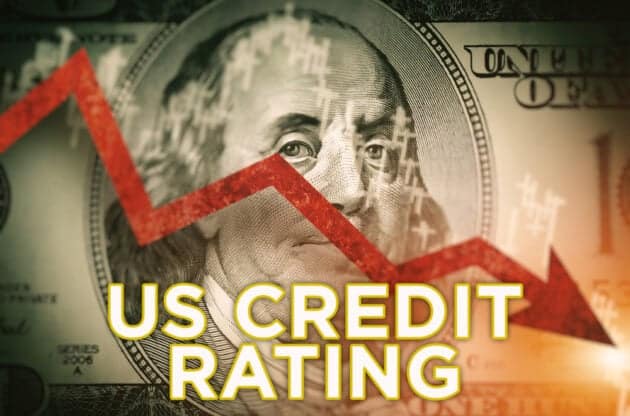Markets dropped Wednesday, with tech stocks leading the Nasdaq lower.
Investors were reacting to the shocking decision by Fitch, a leading credit rating agency, to downgrade the US government’s credit rating.
Fitch says the decision was made due to “the expected fiscal deterioration over the next three years, a high and growing general government debt burden, and the erosion of governance relative to ‘AA’ and ‘AAA’ rated peers.”
But this isn’t the first time America’s credit rating has been downgraded…
In 2011, Standard and Poor’s credit rating agency made a similar decision, primarily due to concerns over the US government’s fiscal situation and the political gridlock surrounding the debt ceiling negotiations at that time.
The downgrade was followed by two tough years with low economic growth.
What potential consequences of a credit downgrade could we see this time?
We may see some or all the following:
Higher borrowing costs: Investors and creditors perceive the US government as a riskier borrower. As a result, we will see higher interest rates on US government bonds to compensate for this increased perceived risk. And it would lead to higher borrowing costs for the US government, which would increase the national debt burden over time.
Market turmoil: A credit rating downgrade could also trigger uncertainty and panic in financial markets. Investors, both domestic and international, may respond by selling US government bonds and other US assets, leading to a decline in prices and a potential sell-off. This could cause volatility and turmoil in financial markets, affecting not only US assets but also global markets.
Further US dollar depreciation: Historically, the US dollar has been considered a safe-haven currency due to our country’s strong credit rating. A downgrade could weaken confidence in the dollar, leading to a depreciation in its value relative to other currencies. And this could lead to higher costs on imported goods.
Higher interest rates: A downgrade could affect interest rates beyond government bonds. Other borrowing costs, such as mortgages, car loans and corporate loans, may also rise as they are often linked to government bond yields. This could affect consumer spending, business investment and overall economic activity.
Weaker confidence: A credit rating downgrade could erode investor confidence in the US government’s ability to manage its finances effectively.
Can we get our credit rating back?
Elliot Hentov, a leading economist who was part of the S&P decision to downgrade the US credit rating in 2011, says no – the US will not get its credit rating back:
“I think it does not take a grand sovereign and analytics genius to understand that the fiscal profile of the U.S. is much worse than it has been, the governance in charge of public debt is much worse than it has been, and it’s frankly not comparable to any of the other AAAs out there.”
In case of doubt, blame Trump
Instead of working to address the issue, the Biden administration went on the offensive: “This Trump downgrade is a direct result of an extreme MAGA Republican agenda defined by chaos, callousness, and recklessness that Americans continue to reject,” said Biden re-election campaign spokesperson Kevin Munoz.
Treasury Secretary Janet Yellen said the downgrade is “arbitrary and based on outdated data.”
Well, here’s what Yellen didn’t tell you.
The interest the US government owed on national debt was $500 billion…
But now, for the first time in US history, the government’s interest bill has risen to over $1 trillion.
Additionally, the US credit risk DROPPED 20 points during Trump’s administration
And it went up more than eight times during Biden’s three years “at the helm.”
Image Courtesy of ZeroHedge
Where is this leading us?
A credit downgrade is a serious declarative mood.
Credit agencies may not take on the US unless it is convinced the current credit rating is inaccurate.
And Biden talks about the economy doing well…
But here’s what Biden isn’t saying (which Fitch saw) …
So far in 2023, the Biden administration’s spending soared 14% YoY to $6.7 trillion, according to the Committee for a Responsible Federal Budget.
The Federal deficit is up by another half a trillion in one year (jumping from $1 trillion to $1.4 trillion).
And the US fiscal policies have America over $32 trillion in debt and growing at an unsustainable pace.
Bottom line
We live in a dollar-denominated world, but our government is damaging the dollar’s buying power. When we may see what some economists have called “The Great Reset” is unknown, but wouldn’t it make sense to prepare yourself with the ultimate hedge to the dollar — gold?
May you be well during these uncertain times.
—————————————————————————————————-
If you’d like to know more about how you can protect your wealth with gold, get a FREE copy of our new Gold Information Kit. Or dial 888-529-0399 now to speak with a Gold Specialist.
July 20, 2023
How the National Debt Will Impact Current and Future Generations
The post US Credit Rating Dropped in Shocking Decision appeared first on Gold Alliance.

